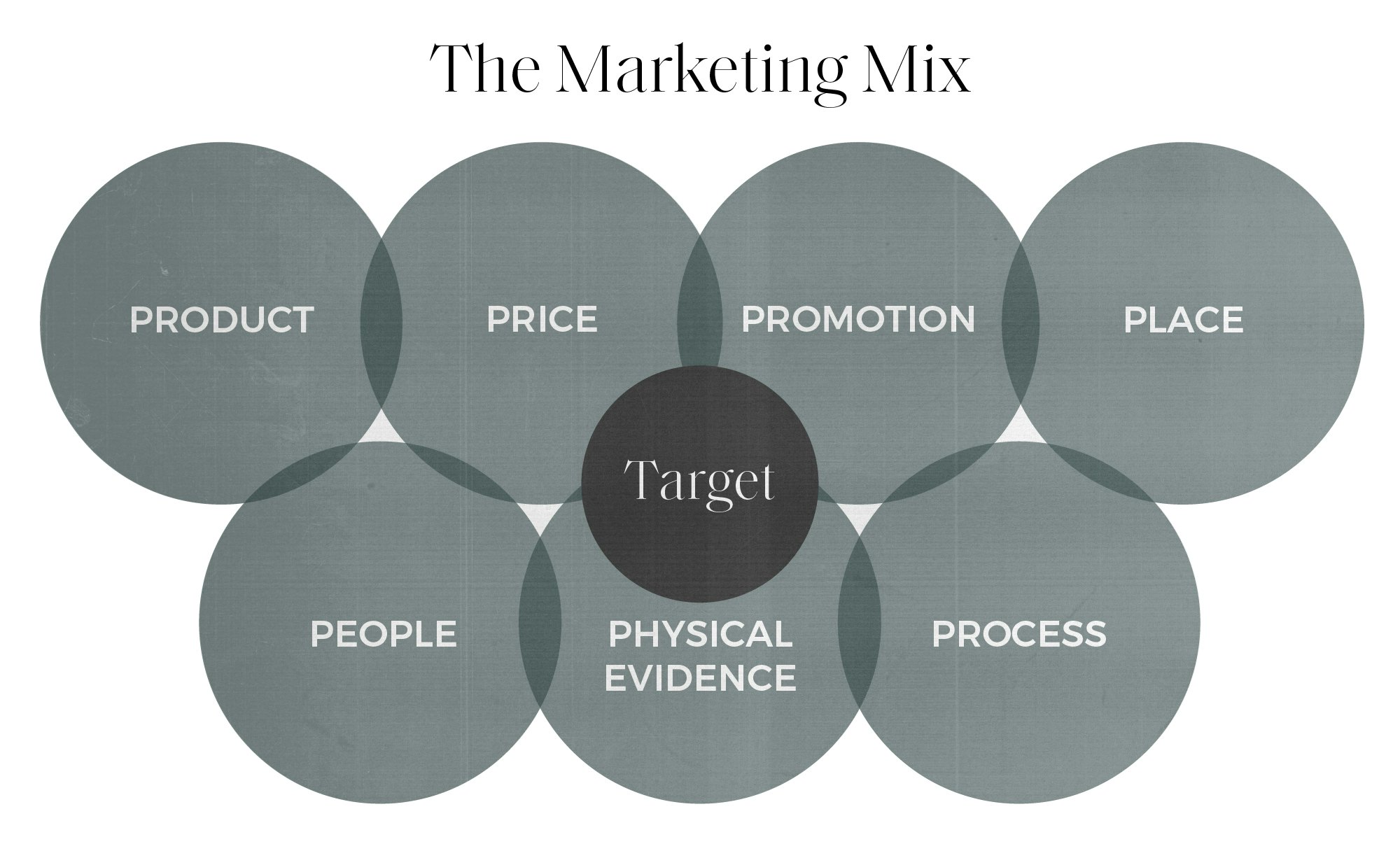If you studied business in school, the four Ps of marketing were probably ingrained in your brain from the first Marketing 101 course you ever took. The Ps of marketing have been around in some form since the ‘60s, and together they make up what is called a marketing mix.
If you didn’t formally study business in school but work in the field today, the now seven Ps of marketing—and the idea of a marketing mix—are probably things you’ve picked up on intuitively. None of these should surprise you, but it does help to revisit the foundations of marketing every once in a while to orient your brand and clarify things that may have changed or become ambiguous over time
Let’s get into it.
Understanding Marketing Mix: The Four Ps
So what’s a “marketing mix,” exactly? Oxford Dictionary defines it as:
A combination of factors that can be controlled by a company to influence consumers to purchase its products.
If you’re still confused after reading this…you’re not alone. It’s broad, and how your marketing mix differs from your marketing strategy can feel like a game of semantics. The main difference, though, is that when people refer to marketing mix they’re really just talking about the four Ps of marketing—the two, for the most part, are interchangeable.

Marketing Mix: The Four Ps of Marketing
The Four Ps of Marketing
As mentioned, the four Ps of marketing make up your marketing mix. The theory of the Ps of marketing has been around for over 50 years. A lot has changed in marketing over that time, but they still provide an easy framework for prioritizing elements of your marketing.
1. Product
First we have the product or service your business provides to your target audience. A product might look different depending on the type of company and what they do. A few examples of products include:
- Uber: An app that lets users find quick rides (and even food options)
- McDonald’s: Consistent fast food including hamburgers, french fries, and chicken products
- Gap: Apparel for men, women, and children
- Amazon: A marketplace that offers quick delivery services
- Salesforce: A CRM and marketing automation tool for businesses
A few things to think about when it comes to your product include:
- What does your product or service do for customers?
- How does your audience use your product or service?
- What is unique about your product or service?
- What are the benefits to using your product or service?
- How is your product or service different from what your competitors offer?
- How is your product or service branded?
- How many products or services do you offer? What is the architecture of these products?
2. Place
Next we have place—where and how people buy your product. Out of the four Ps, this is probably the one that has changed the most over the years, especially with the rise of the internet—but that doesn’t mean it’s no longer important. A few examples of places consumers can buy products and services include:
- Online via a web browser
- Online through an app
- Retail locations
- Through trade shows or events
- Through marketplace channels like Amazon or Walmart
- Through a sales professional
A few things to keep in mind when thinking about place include:
- How does your audience shop?
- Where can consumers buy products from your competitors?
- Which channels provide a great experience for your customers?
- Do you need sales reps to assist with buying your product?
- How are people accustomed to buying your product or service? Is there an opportunity for customers to purchase through a new channel?
3. Price
The third part of a marketing mix is price—how much your product or service costs. This one is pretty self explanatory, and largely depends on your competitors, demand, cost to produce the product, and what consumers are willing to spend, among other things. From subscription models to one-time purchases, there are also plenty of pricing models to consider. Here are a few questions to think about when it comes to pricing:
- What’s the value of the product to the consumer?
- What are the market averages for this type of product or service?
- How do you compare to your competition when it comes to pricing?
- What type of pricing structure makes sense for your business?
4. Promotion
Out of all of the Ps of marketing, promotion is the one that probably feels most applicable to the everyday marketer. Promotion refers to how you reach your target market with the right message at the right time. It’s what we think of when we think about marketing—pushing specific and thoughtful advertising and content through the channels our audience spends time in.
A few examples of promotion could include:
- An organic Instagram campaign
- A multichannel campaign to support a sale or offer
- A PR campaign to showcase a new product or service
- An email campaign to promote a resource or guide that your target audience might find useful
When thinking about promotion, it’s good to consider the following questions:
- Which part of my target audience do I need to engage?
- Where does my audience get information?
- When is the right time to push this offer or campaign?
- Which channels are the most efficient and cost effective for my campaign?
- Where are my competitors spending their marketing efforts and advertising dollars?
Variations and Additions: The Seven Ps of Marketing
The four Ps are the oldest and most widely known by marketers and business leaders. On top of the foundational four Ps, a few more have been added to the marketing mix over the years to account for service industries and other changes in marketing.

Marketing Mix: The Seven Ps of Marketing
5. People
In this case, “people” doesn’t mean your marketing team. Instead, the idea of people is specific to service industries, and represents those who are interacting with your customers or providing the service.
Examples of people-related focus areas in reference to the extended Ps of marketing:
- Customer service representatives and their interactions with customers
- Business or marketing consultants
- Brand of uniforms and service workers
- Customer success and overall satisfaction
6. Process
As you may have guessed, process refers to the flow of how the service is executed. Again, this is good to think about through a service-industry lens. For example, if your business is a spa or salon, the process might be to ensure new customers are greeted upon arrival, offered a beverage while they wait, and asked to book their next appointment upon departure.
7. Physical Evidence
Physical evidence refers to the space in which a customer experiences your service. Piggybacking off our previous spa example, the physical evidence for a spa might include the actual location and interior design of the space, the equipment used as part of the service, signage and branding throughout the building, and any tangible products the customer leaves with.
Examples of physical evidence include:
- Signage
- Interior spaces
- Equipment used in the service
- Scents, smells, sounds, or other ambient choices
Despite its name, it’s smart to think through this concept in the digital space as well—how do customers experience your service through an app? What about through a website? While this might blur into the product (for example, Uber’s product is their app), physical evidence is still a concept that can be applied to the product.
Okay, So Why Is Marketing Mix Important?
The four Ps set the foundation—and the three extended Ps help make the structure more relevant to marketers in service industries. But why do people care about the marketing mix?
My best answer: it’s a somewhat elegant framework to think through all the things that affect whether or not people will buy from you.
As a marketer, you’re probably not thinking about all of these concepts every day. You’re probably not even thinking about half of them (like I said before, I’m convinced most marketers are really thinking about promotion the most). That said, when confusion strikes or you’re just trying to reassess who you are, what you do, and why your customers love you, it’s helpful to step back and clarify each of these Ps:
- What do you sell?
- How can people buy your product?
- How expensive is your product?
- How are you marketing your product?
- Who is representing your company?
- How is your service being delivered to the customer?
- In what kind of environment do customers experience your service?
Not only will this foundation align your team, but it will also help you go to market with confidence and clarity.
[e3_writer_bio]





